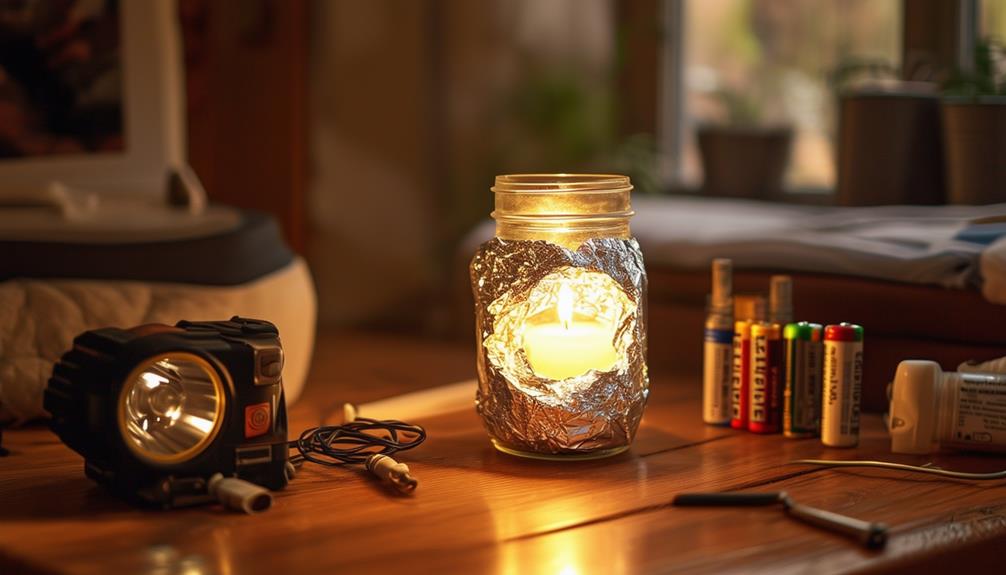Best Practices for Storing Emergency Lights and Supplies
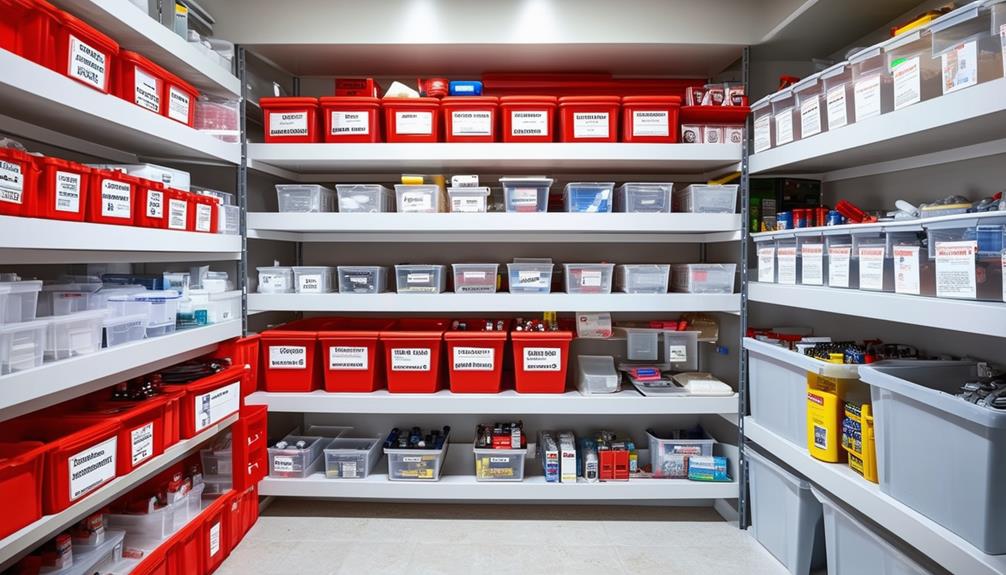
When storing emergency lights and supplies, it's crucial to go beyond merely placing them in a drawer. Have you considered how a designated storage area can significantly impact your preparedness during a power outage or natural disaster?
Keeping your emergency gear in a cool, dry place is essential, but there are other factors to consider as well. For instance, discovering that your flashlight batteries are dead or your supplies have expired at the moment you need them most can be incredibly frustrating.
How can you ensure your emergency items are always ready for use? Let's explore the key practices that can make all the difference.
Designated Storage Area

Always designate a specific storage location for emergency lights and supplies to ensure easy access and organization. This precaution ensures that in times of need, you can quickly locate necessary items. Choose a secure spot that's easily accessible to everyone in your household or team, saving valuable time during emergencies.
To enhance organization, implement a labeling system. Clearly mark shelves, bins, or cabinets with labels indicating the type of emergency lights and supplies stored in each. For instance, label one shelf for flashlights, another for batteries, and a separate container for first aid supplies. This allows you to find what you need swiftly and without sifting through clutter.
Maintaining this storage area is crucial. Regularly check the space to ensure everything is in its proper place and that labels remain legible. A well-organized storage area not only ensures quick retrieval during emergencies but also helps you monitor your inventory, making it easier to know when supplies need replenishing.
Cool, Dry Environment
To ensure your emergency lights remain functional when needed, store them in a cool, dry environment. This practice is essential for maintaining optimal battery performance. High temperatures can significantly reduce battery life and overall efficiency. By keeping your lights in a cooler setting, you prevent premature battery degradation, ensuring they'll work during emergencies.
Moisture is another threat to emergency lighting equipment. Storing lights in humid areas can lead to corrosion and malfunctions. A dry environment helps prevent these issues, keeping your lights in good working order. Corrosion can damage internal components, rendering the lights useless in emergencies.
A cool, dry storage space not only extends the lifespan of your emergency lighting supplies but also ensures they're ready for use when an emergency occurs. Regularly check your storage area for signs of temperature fluctuations or moisture. This practice will protect your investment and enhance your safety preparedness. Proper storage conditions are key to reliable emergency lights and optimal battery performance.
Avoid Direct Sunlight
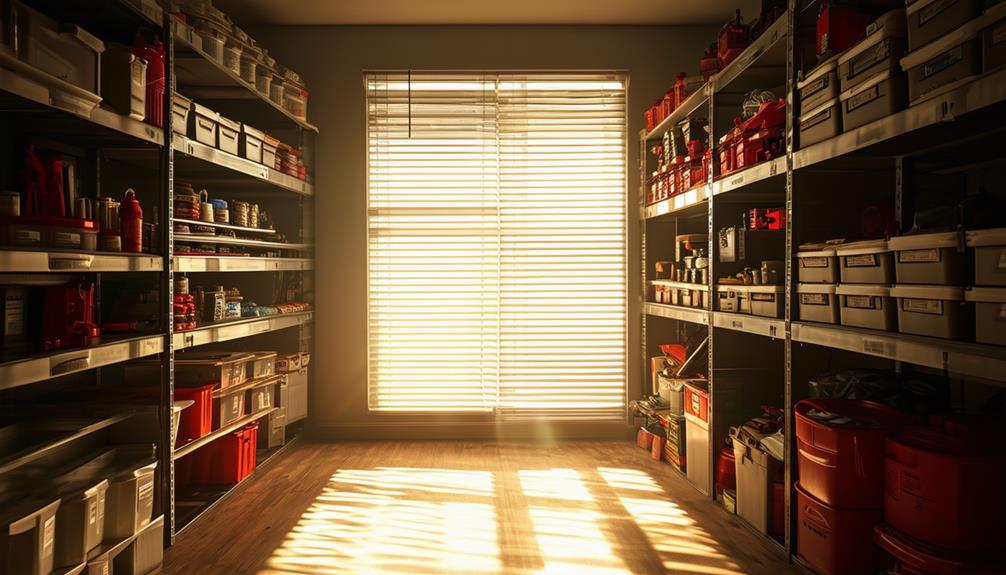
To protect your emergency lights and supplies, store them away from direct sunlight. Exposure to sunlight can cause overheating and UV damage, compromising the functionality and lifespan of your equipment.
Temperature Control Measures
To ensure the longevity and functionality of your emergency lights and supplies, store them in temperature-controlled environments away from direct sunlight. Exposure to sunlight can cause overheating and degrade battery performance, leading to premature failure.
Keeping your emergency lights in shaded, cool areas helps maintain optimal battery performance and prevents heat damage, ensuring reliability during emergencies.
High temperatures can also compromise other emergency supplies, such as first aid kits, canned food, and water. By storing all your emergency items in a cool, shaded space, you can preserve their integrity and readiness for when you need them most. Taking these precautions guarantees that your emergency supplies remain effective and dependable.
UV Radiation Protection
Direct sunlight can significantly damage your emergency lights, leading to faster deterioration and reduced reliability. UV radiation can cause discoloration, fading, and degradation of materials in your emergency lighting systems. When lights are exposed to direct sunlight, the components, especially plastics, degrade more quickly.
Here's how you can protect your lights from sun damage:
- Store in Shaded Areas: Always keep your emergency lights in places where they won't be exposed to direct sunlight. A shaded area, like a closet or a drawer, can substantially reduce the harmful effects of UV radiation.
- Use UV-Resistant Cases: If you have to store your lights in a somewhat exposed area, consider investing in UV-resistant storage cases. These cases can shield your lights from the damaging effects of direct sunlight exposure.
- Regularly Check Storage Locations: Make it a habit to check where you store your emergency lighting systems. Ensure that even over time, these spots remain free from direct sunlight, which can sneak in through windows or other openings.
Protect From Extreme Temperatures
Extreme temperatures can severely impact the functionality of your emergency lights, leading to malfunctions when they are needed most. To ensure the reliability of your emergency lighting, store them in environments where temperature extremes are avoided. Excessive heat can warp, melt, or even cause lights to burst, while extreme cold can make them brittle and prone to failure.
Avoid locations with significant temperature fluctuations, such as attics, garages, or outdoor sheds. Opt for stable environments like climate-controlled rooms to ensure their longevity. Additionally, high humidity can cause condensation, leading to corrosion and electrical failures.
Here's a quick reference table for ideal storage conditions:
| Temperature Range | Humidity Level | Recommended Storage Locations |
|---|---|---|
| 60-75°F (15-24°C) | 30-50% | Inside closets |
| 60-75°F (15-24°C) | 30-50% | Basements (with dehumidifiers) |
| 60-75°F (15-24°C) | 30-50% | Climate-controlled rooms |
| 60-75°F (15-24°C) | 30-50% | Interior rooms |
| 60-75°F (15-24°C) | 30-50% | Under-bed storage |
Proper storage ensures your emergency lights remain ready for use. By protecting them from extreme temperatures, you're safeguarding a crucial component of your emergency preparedness plan. Maintaining a stable environment for these vital tools is essential for their reliability.
Sealed Containers for Supplies

To further safeguard your emergency lights and supplies, storing them in sealed containers is highly effective. Sealed containers offer numerous benefits for maintaining the integrity and functionality of your emergency items. By keeping dust, moisture, and potential damage at bay, you ensure that your supplies are always in peak condition when you need them most.
Using transparent, airtight containers for storage is a smart move. These containers allow you to quickly see the contents and prevent corrosion and degradation of batteries and electrical components.
Here are three key advantages of using sealed containers:
- Visibility: Clear containers help you easily identify the contents, simplifying inventory management.
- Protection: Airtight seals keep out moisture and dust, which can damage emergency lights and other supplies.
- Organization: Containers with secure lids ensure that your supplies remain intact and orderly during storage.
Additionally, proper labeling on these containers is essential for identifying contents and tracking expiration dates. This helps you efficiently rotate supplies, ensuring everything is up-to-date.
Regular Equipment Inspection
Regularly checking your emergency lights ensures they're operational when needed most. Inspections are crucial for identifying damage, corrosion, or malfunctions in your emergency lighting system. Routine checks allow you to detect potential issues before they escalate into serious problems.
During inspections, focus on battery life to confirm it can adequately power the lights during an emergency. Ensure the lights are clean and free from dust and debris, as these can affect performance. Verify proper installation, as incorrectly installed lights may fail in critical moments.
Routine inspections not only prevent failures but also ensure compliance with safety regulations. Adhering to these regulations safeguards your property and the safety of its occupants. Maintaining detailed records of each inspection helps you manage maintenance tasks and demonstrate compliance when required.
Timely maintenance based on inspection findings can significantly extend the lifespan of your emergency lighting equipment. Addressing issues promptly ensures the reliability of your emergency lights, providing peace of mind and enhanced safety.
Damage and Expiration Check
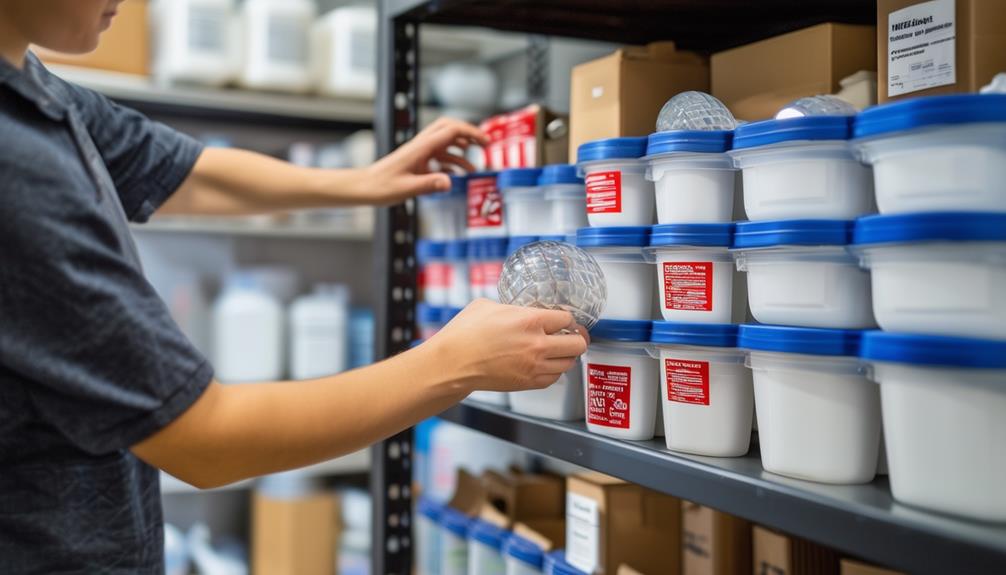
Ensuring your emergency lights are free from damage and not expired is vital for their proper functioning during emergencies. Regular inspections can help you identify and address issues before they become critical.
Follow this guide for effective damage checks and expiration verification:
- Physical Inspection: Examine the emergency lights for cracks, dents, or corrosion, as these can impair performance. Check wiring and connections for signs of wear or fraying.
- Expiration Dates: Verify the expiration dates on batteries and light bulbs, as expired components can fail during an emergency. Replace any expired parts immediately to ensure reliability.
- Routine Maintenance: Perform regular maintenance to ensure all components are in good working order. Replace damaged parts and test the lights to confirm proper operation.
Organized and Marked Storage
Clearly mark and neatly organize your storage areas to ensure you can quickly locate emergency lights and supplies when needed. Properly labeled storage locations are essential for easy identification in urgent situations.
Start by categorizing your emergency lights and supplies based on type, size, or function, so you'll know exactly where to look when time is of the essence.
Implement a comprehensive labeling system for shelves and containers. Labels should include the contents and expiration dates of the items inside, allowing you to quickly assess what's available and what needs replacement.
Using transparent containers or bins is another effective strategy, as they enable visual inspection of your supplies without opening each box, saving valuable time.
Regular checks and rotations of stored emergency lights and supplies are crucial. This practice ensures that everything remains in peak condition and prevents expiry.
Maintain Battery Health
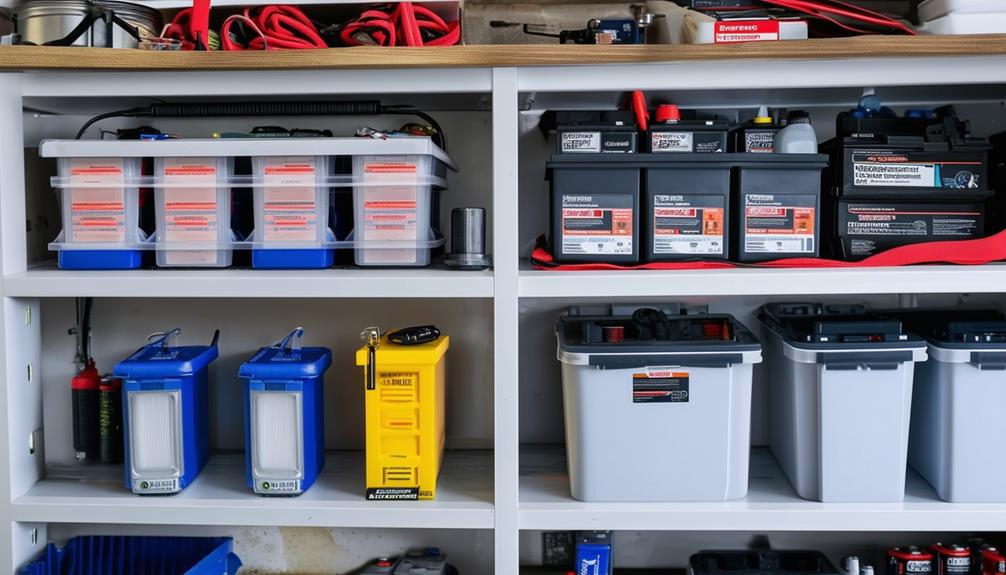
To maintain battery health, you should conduct monthly tests to ensure proper functionality. Store batteries in a cool, dry place to prevent damage and extend their lifespan. Regularly clean the terminals to avoid corrosion and keep them in optimal condition.
Monthly Battery Testing
Regular monthly battery testing is crucial to ensure that your emergency lights will operate during power outages. Maintaining a consistent testing schedule helps you monitor the health of your emergency lighting system and promptly address any potential issues. Failure to conduct monthly tests can result in battery failures, leaving you without light during emergencies.
To preserve battery health and ensure reliable performance, follow these three steps:
- Schedule Regular Tests: Set a fixed date each month for testing. Consistency is essential to identify issues before they become critical.
- Conduct Thorough Inspections: During each test, inspect the battery terminals for signs of wear, tear, or corrosion. Ensure the emergency lights remain on for the required 90-minute duration.
- Document Results: Maintain a log of each test, including the date, results, and any corrective actions taken. This documentation helps track battery performance over time and identify recurring problems.
Proper Storage Conditions
Storing your emergency lights in a dry, temperature-controlled environment is crucial for maintaining battery health and ensuring they're ready for use when needed. Moisture can lead to corrosion, which degrades battery performance over time. To prevent this, always select a storage location free from humidity and dampness.
Avoid extreme temperatures when storing your emergency lights. Excessive heat can cause batteries to overheat and lose their charge more rapidly, while extreme cold can reduce battery efficiency and potentially cause permanent damage. A consistent, moderate temperature is optimal for preserving battery life.
If you anticipate not using your emergency lights for an extended period, disconnect the batteries. This simple step prevents unnecessary drainage and helps maintain battery health.
Before storing the lights, check for any signs of corrosion or damage on the batteries. Addressing these issues in advance ensures your lights will be in optimal condition when needed.
Regular Cleaning Practices
Maintaining your emergency lights through regular cleaning is essential for ensuring their battery health and optimal performance. Accumulated dirt and debris can impair the functionality of your emergency lights, reducing both their lifespan and effectiveness. Implementing a proper cleaning routine ensures that your emergency lights are always ready to perform during power outages.
Here's an effective and straightforward cleaning routine:
- Clean the light lenses: Dust and grime on the lenses can obstruct light output. Use a 50/50 mix of white vinegar and water to gently wipe the lenses clean.
- Wipe down the light bars and mounting hardware: Dirt buildup on these surfaces can lead to corrosion. Regular cleaning helps prevent this damage.
- Inspect battery contacts: Debris on battery contacts can interfere with connections and compromise battery health. Carefully clean the contacts using a soft cloth.
Protect From Moisture and Dust
To protect your emergency lights and supplies from moisture and dust, store them in moisture-proof and airtight containers. This method effectively prevents damage from humidity, rust, corrosion, and mold.
Airtight storage bins are also crucial as they prevent dust and debris from affecting the performance of your emergency items over time. Regularly inspect these containers for any signs of moisture or dust buildup. If issues are detected, address them immediately to avoid long-term damage.
Additionally, consider placing desiccants or moisture-absorbing packets inside the storage containers to control humidity levels further. Proper sealing of these storage areas will extend the lifespan of your emergency supplies, ensuring they remain effective when needed.
Conclusion
To keep your emergency lights and supplies in optimal condition, store them in a designated, cool, and dry area. Use sealed containers, avoid extreme temperatures, and protect items from direct sunlight.
Regularly inspect for damage and expiration dates, and ensure battery health is maintained. Clearly label and organize everything for quick access. By adhering to these best practices, you ensure your emergency supplies are ready when needed most.


